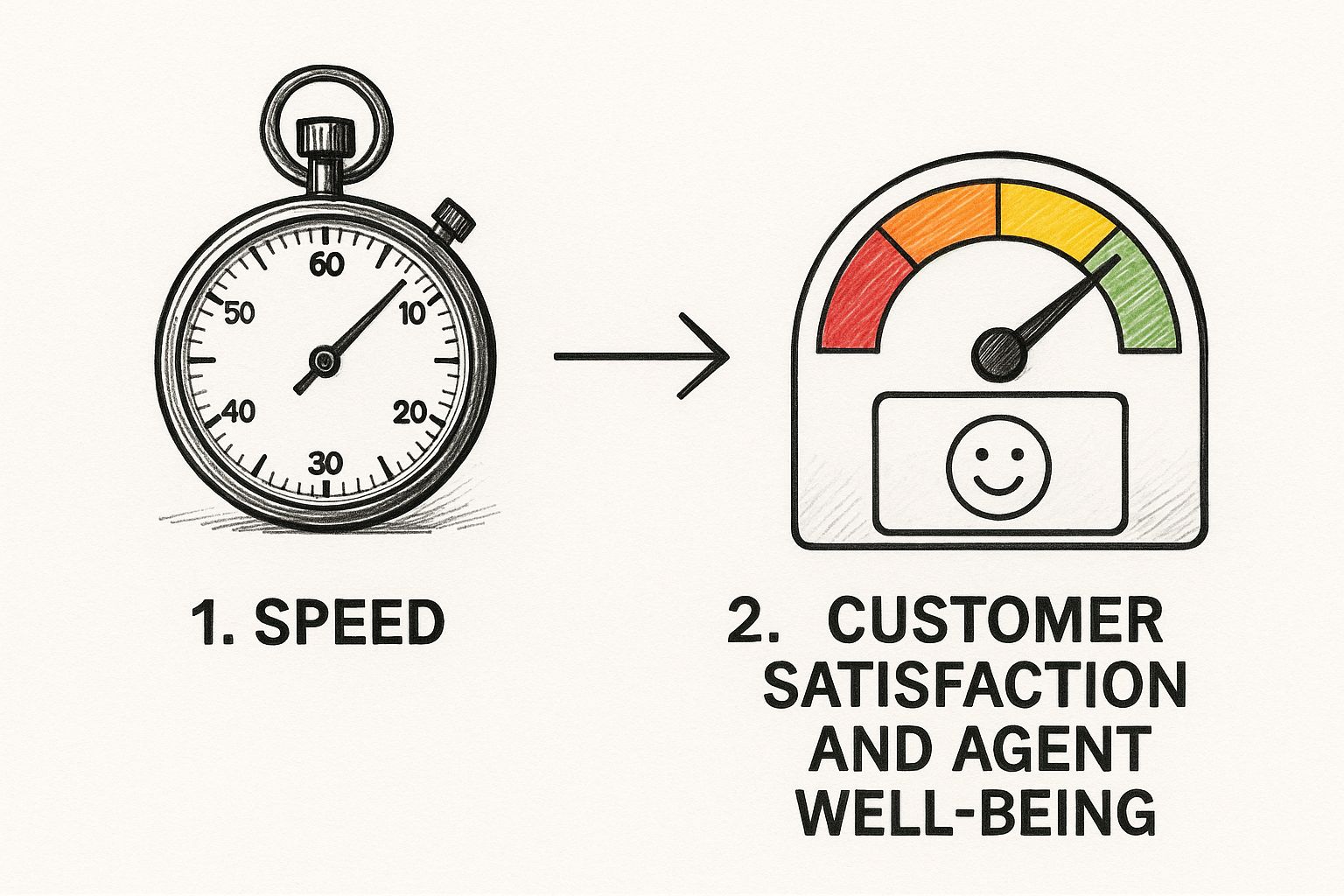Improve Agent Productivity with AI Automation

To really boost agent productivity, we need to stop looking at the clock and start focusing on results. True productivity isn’t about how fast an agent can get off the phone; it’s about solving a customer’s problem on the first try (First Call Resolution) and leaving them satisfied. The best way to get there is by equipping your team with smart tools that help them do their best work.
Redefining Agent Productivity Beyond Old Metrics
For a long time, the contact center world has been fixated on speed. The old-school thinking was simple: a faster agent is a more productive agent. This led to a laser focus on metrics like Average Handle Time (AHT). But while efficiency has its place, this narrow viewpoint often backfires, hurting the very productivity it’s supposed to improve.
Think about it. When agents are pressured to hit aggressive AHT targets, they start cutting corners. They might give half-baked answers or pass a call off too quickly just to stop the clock. This creates a revolving door of frustrated customers who have to call back, which completely tanks your First Call Resolution rate and sends satisfaction scores plummeting. It’s a textbook example of winning a small battle but losing the much bigger war for customer loyalty.
Moving From Speed to Substance
A more effective, modern approach means we have to fundamentally change how we measure success. Instead of asking, “How quick was that call?” the real question should be, “Did we actually solve the customer’s problem?” This simple shift puts the emphasis right where it belongs: on quality and completeness.
This infographic paints a clear picture of this evolution, moving away from outdated speed metrics toward a more balanced view that includes customer satisfaction and agent well-being.

As you can see, genuine performance is about balancing efficiency with customer happiness and agent support—it’s not just a race against time. Key performance indicators (KPIs) like First Call Resolution (FCR), Average Handle Time (AHT), and After-Call Work (ACW) are all critical for measuring agent productivity, but FCR has a direct and powerful impact on both customer satisfaction and operational efficiency.
The real cost of an unresolved issue isn’t just one bad call—it’s the repeat calls, the negative sentiment, and the potential for customer churn. Prioritizing FCR over AHT is an investment in long-term loyalty and efficiency.
To track this shift effectively, it helps to compare the old way of thinking with the new.
Modern vs. Traditional Agent Productivity Metrics
This table contrasts the outdated metrics we’re trying to move away from with a more holistic, modern approach that balances efficiency with the well-being of your agents and the satisfaction of your customers.
| Metric Focus | Traditional Approach | Modern Approach |
|---|---|---|
| Primary Goal | Minimize call duration (AHT) | Maximize first-contact resolution (FCR) |
| Agent Role | Call handler, focused on speed | Problem solver, focused on quality |
| Customer View | A ticket to be closed quickly | A relationship to be nurtured |
| Success Metric | Low Average Handle Time | High Customer Satisfaction (CSAT) scores |
| Agent Well-being | Often overlooked, leading to burnout | A key factor in performance and retention |
This side-by-side comparison makes it clear that the modern approach isn’t just about different metrics; it’s a completely different philosophy for running a successful contact center.
The Hidden Costs of an Outdated Model
Focusing only on speed has another significant casualty: your agents. A high-pressure environment that treats people like cogs in a machine is a perfect recipe for burnout and high turnover. The constant stress and feeling of being just a number leads to disengagement, which is a direct drain on performance.
To truly understand and improve how your agents perform, you have to look beyond the old numbers and explore a wider range of employee performance metrics. By embracing a more complete view that values quality work and supports the people doing it, you can build a foundation for sustainable, high-impact productivity that lasts.
Offload Repetitive Tasks and Give Your Team Their Time Back
Every minute an agent spends on manual, repetitive work is a minute they aren’t using to help a customer. Just think about the collective time suck from tasks like logging call notes, updating CRM records by hand, and categorizing support tickets. These little jobs add up fast, putting a serious drag on your team’s capacity and focus.
The secret to getting that time back is smart, targeted automation.
Picture this: an agent wraps up a complicated support call. Instead of spending the next ten minutes typing out a summary and clicking through fields in the CRM, the system has already handled it. While the conversation was happening, an AI tool was transcribing the call in real-time, creating a neat summary, and automatically filling in the CRM with the customer’s issue and how it was resolved. The agent just gives it a quick once-over and is ready for the next customer. That’s how you fundamentally improve agent productivity.
Slash After-Call Work with Smart Tagging
One of the quickest wins you’ll see from automation is the reduction of After-Call Work (ACW). This is all that administrative time agents spend finalizing an interaction, and it’s a notorious productivity killer. By setting up the right automations, you can practically make it disappear.
With a tool like Sagekit, you can build workflows that automatically analyze what was said during a conversation. Here’s what that looks like in the real world:
- Automatic Topic Tagging: The AI scans for keywords and phrases to categorize the interaction for you (e.g., “billing inquiry,” “technical issue,” “product return”).
- Sentiment Analysis: The system can also read the customer’s emotional state—frustrated, happy, neutral—and tag the ticket so you know if it needs a follow-up or a manager’s review.
This hands-off process keeps your data consistent and lifts the mental load of manual data entry off your agents’ shoulders. They can transition from one customer to the next without the friction of administrative cleanup, keeping their energy focused on problem-solving. If you want to dive deeper into how this works, our guide on what is workflow automation is a great place to start.
The Real-World Impact on Performance
This isn’t just a futuristic idea; it’s rapidly becoming the industry standard. AI-driven analytics are being used more and more for real-time sentiment analysis, a technology that’s expected to be used in 95% of all interactions by 2025. This gives agents the power to adapt their approach on the fly based on a customer’s mood, which in turn cuts down on post-call work and unnecessary escalations.
By automating the routine, you empower the exceptional. When agents are freed from monotonous tasks, they have the bandwidth to build genuine rapport, handle complex escalations, and create the positive experiences that drive customer loyalty.
For teams new to automation, the path might seem a bit daunting, but it all starts with one simple step: identifying your most time-consuming manual tasks. For a practical walkthrough on getting started, you can learn how to automate customer service with a step-by-step approach. You’d be surprised how much of a difference even one or two well-placed automations can make to your team’s output and overall morale.
Empowering Agents with Real-Time AI Assistance
What if every agent had an expert co-pilot sitting next to them on every single call? That’s the reality with real-time AI assistance. Instead of just reacting to problems after the fact, you can proactively give your team the tools they need to shine in the moment. This is a game-changer for improving agent productivity without piling on more stress.
This isn’t about micromanaging or surveillance; it’s about genuine support. Think of real-time AI as an instant safety net, giving agents the confidence to tackle tricky customer issues head-on.

Instant Answers with Agent Assist
One of the most practical applications of this tech is Agent Assist. This tool actively listens to live conversations and automatically pushes relevant information to the agent’s screen exactly when they need it.
Let’s say an agent gets a tough question about a recently updated billing policy. Instead of the dreaded, “Let me put you on a brief hold while I check on that,” Agent Assist instantly pops up the right policy document or knowledge base article. The customer gets a quick, correct answer, and the agent avoids a frantic scramble through internal files.
I’ve seen this feature have a direct, measurable impact on the metrics that matter most:
- Reduced Handle Time: Agents get the info they need in seconds, not minutes. It’s that simple.
- Increased FCR: When agents have the right answers right away, they’re far more likely to solve the problem on the first try.
- Improved Agent Confidence: New hires feel more secure, and even seasoned pros appreciate having a reliable backup.
The real magic here is how Agent Assist turns your knowledge base from a static library into an active, intelligent partner. It makes sure your team’s collective wisdom is right there for every agent, on every single interaction.
Of course, a powerful Agent Assist tool is only as good as the information it’s fed. A solid knowledge base is the foundation. To get the most out of it, check out our guide on knowledge management best practices to get started.
Consistent and Accurate Responses
Beyond just digging up documents, AI can also suggest real-time responses for agents working in chat and email. This is incredibly helpful for maintaining a consistent brand voice and ensuring everyone provides accurate information.
Picture this: a customer emails you, frustrated that a popular product is out of stock. The AI can instantly suggest a pre-approved, empathetic response that includes:
- A sincere apology for the hassle.
- An estimated restock date, if available.
- A helpful link to a similar product that’s in stock right now.
The agent can then use this template as a starting point, adding a personal touch before hitting send. This little bit of automation saves time, cuts down on errors, and ensures every customer gets the same high-quality communication. By providing this kind of in-the-moment support, you can turn a potentially negative experience into a chance to build real trust.
Great coaching is the secret sauce for any top-tier team, but let’s be realistic—managers can’t listen to every single call. Manually picking a few calls to review each week gives you a tiny, and often biased, glimpse into an agent’s real performance. This is where AI analytics steps in and completely rewrites the coaching playbook, shifting it from a guessing game to a data-driven strategy.
Instead of spending hours hunting for those elusive “coachable moments,” you can have the AI bring them right to your doorstep. This is a game-changer for improving agent productivity because you’re focusing your time and energy exactly where it will make the biggest difference.
Think about it: what if a system could automatically flag every single time a customer showed serious frustration? That’s exactly what AI-powered sentiment analysis does. It scans conversations for specific keywords, phrases, and even shifts in tone that signal a negative experience. Suddenly, you’re not relying on luck to find critical learning opportunities; the most important calls are surfaced for you.
Pinpointing Specific Skill Gaps
Once the AI flags a challenging interaction, you can really drill down into the details. AI-driven topic analysis can tell you precisely why the customer was upset. Did the agent stumble when trying to explain a tricky billing issue? Were they hesitant when talking about a new product feature?
This level of detail completely transforms your feedback. You can finally move past vague advice and give targeted, actionable guidance.
Instead of saying, “You need to be more empathetic,” a manager can now say, “Let’s look at this AI-flagged call together. The system noted the customer became frustrated when the return policy came up. Let’s brainstorm a clearer way to walk through those steps so it doesn’t happen again.”
When you lead with data, coaching sessions become far more productive and a lot less confrontational. It stops being about pointing out what went wrong and becomes a collaborative effort to solve specific, identified challenges.
To truly understand the shift this brings, it’s helpful to compare the old way with the new.
AI-Driven Coaching vs. Traditional Call Monitoring
This table highlights the key differences between manual call review and using AI analytics for targeted, effective agent coaching and development.
| Coaching Aspect | Traditional Method | AI-Powered Method with Sagekit |
|---|---|---|
| Performance Visibility | Small, random sample of calls (typically <2%) | 100% of all customer interactions are analyzed |
| Identifying Issues | Relies on luck and manual searching | AI automatically flags key moments (e.g., frustration, non-compliance) |
| Feedback Quality | Often general and subjective (“Be more confident”) | Specific and data-backed (“Let’s work on the ‘refund process’ script”) |
| Efficiency | Time-consuming; managers spend hours listening | Managers receive prioritized alerts, focusing time on high-impact coaching |
| Agent Buy-in | Can feel like micromanagement or unfair judgment | Perceived as objective, fair, and focused on genuine improvement |
Ultimately, the AI-powered approach moves coaching from a reactive, and often inconsistent, process to a proactive and data-informed one, building stronger skills and trust with your team.
Setting Up Performance Dashboards That Matter
To make this all work in the long run, you need dashboards that track the right things. It’s time to move beyond simple metrics like average handle time and start focusing on goals that actually reflect quality and effectiveness. With a platform like Sagekit, you can set up your analytics to monitor key performance indicators that tell the whole story.
Consider building your dashboards around metrics like these:
- Customer Satisfaction Scores: Connect CSAT and NPS scores to specific topics or agent behaviors to discover what truly drives great experiences.
- First Call Resolution Rates: See which issues are constantly requiring follow-up calls and use that data to refine your training programs.
- Compliance Adherence: Let the AI automatically check if agents are hitting their required script points or disclosure protocols, ensuring consistency and reducing risk.
By bringing AI analytics into your coaching workflow, you’re not just adding a new tool—you’re empowering your managers to be better leaders. They can stop searching for problems and start developing their people, leading to a real, sustainable boost in both performance and morale.
Reducing Agent Burnout to Boost Retention
High turnover is the silent killer of contact center productivity. I’ve seen it time and time again: when your best agents walk out the door, they don’t just leave a vacant seat. They take a massive amount of tribal knowledge with them, forcing you to constantly pour time and money into training replacements. This isn’t just a budget problem—it directly chips away at the quality of service your customers experience.
The good news is that AI automation offers a way to break this vicious cycle by tackling one of the biggest drivers of agent churn: burnout.

The constant pressure to hit metrics, combined with an endless stream of monotonous tasks, creates serious cognitive strain. Think about it. When an agent is buried in after-call work or scrambling to find the right article in a messy knowledge base, they can’t jump into the next customer interaction feeling fresh. They feel drained and checked out.
And this isn’t a small problem. Agent attrition hit a staggering 52% annually in 2023. On top of that, a recent survey found that three out of four agents feel overwhelmed by having to navigate too many systems and too much information. You can dig into more of these eye-opening contact center benchmarks on Plivo.com.
Creating a Supportive Work Environment
The first real step toward easing this pressure is automating the repetitive, mind-numbing tasks. When you can offload things like call summaries, CRM data entry, and ticket categorization to AI, you give your agents their most valuable resource back: mental energy.
This frees them up to focus on the distinctly human parts of their job—showing empathy, solving complex problems, and building a real connection with customers.
Beyond just handling the admin work, real-time AI assistance acts as a crucial support system during live interactions. It’s like a safety net, making sure agents always have the right information right when they need it. This takes away the stress of not knowing an answer and gives them the confidence to navigate even the trickiest conversations. Some tools take this even further, like an AI scheduling assistant that can book follow-up appointments without the agent ever needing to switch screens.
A supported agent is an effective agent. Investing in tools that reduce their daily friction isn’t just a perk; it’s a core strategy for building a stable, experienced, and highly productive team.
Fostering Fairness and Transparency
Burnout isn’t just about workload; it’s also about feeling like you’re being judged unfairly. We’ve all been there. Traditional performance reviews, often based on a manager listening to a handful of randomly selected calls, can feel completely arbitrary. This is another place where AI can make a huge impact.
AI-powered analytics create a far more transparent and equitable way to evaluate performance. By analyzing 100% of interactions, the system can pinpoint areas for improvement based on objective data, not just a manager’s gut feeling from a few calls.
This data-driven approach changes the game in a few key ways:
- Objective Feedback: Coaching becomes genuinely constructive when it’s tied to specific, measurable moments instead of subjective opinions.
- Fair Recognition: Your true top performers get noticed for their consistent, high-quality work, not just because a manager happened to overhear one great call.
- Boosted Morale: Agents feel more valued and secure when they know their performance is being assessed fairly and comprehensively.
When agents feel supported, evaluated fairly, and freed from the most draining parts of their job, they stick around. And that stability is the true foundation of sustainable productivity.
Common Questions About AI in the Contact Center
When you’re thinking about bringing AI into your support operations, a lot of questions pop up. It’s a big shift. Let’s tackle some of the most common things managers and team leads ask when they’re looking to boost their team’s productivity with automation.
Is AI Going to Replace Our Agents?
This is probably the number one concern I hear, and it’s a valid one. But the reality is that tools like Sagekit are built for augmentation, not replacement. The goal isn’t to get rid of your people; it’s to get rid of the tedious, soul-crushing parts of their job.
Think about all the time agents spend on manual data entry, writing up call summaries, or tagging tickets. That’s where AI shines. It takes over that administrative load, freeing up your team to focus on what humans do best: complex problem-solving, showing real empathy, and building lasting relationships with your customers. It makes their jobs more valuable and interesting, which is a huge win for morale and retention.
How Quickly Will We Actually See a Difference in Productivity?
You’ll see some wins almost right away, but the biggest impact doesn’t happen overnight. Things like After-Call Work (ACW) will drop pretty much the moment you turn on automations for call summaries. That’s an immediate, tangible benefit.
However, seeing a real jump in bigger-picture metrics like First Call Resolution (FCR) or your CSAT scores usually takes a bit longer—think a few weeks to a full quarter.
It’s a phased process. First, you get everything set up. Then you train your team. The real magic happens when you start using the AI-powered analytics to spot coaching opportunities and make your processes even smarter.
My advice? Start small. Pick one or two automations that will make a big difference, like automatic summaries, and build from there. Keep a close eye on your key metrics so you can see the progress and show everyone the value it’s delivering.
Can AI Really Help Us Onboard New Hires Faster?
Absolutely. This is one of the most powerful uses for AI in a contact center. Think of Sagekit’s real-time assistance as a personal co-pilot for every new agent. It’s a safety net that gives them answers from your knowledge base and suggests what to say right in the middle of a live call.
This completely changes the onboarding game. It takes the pressure off and means they don’t have to ping a supervisor for every little thing.
Here’s what that looks like in the real world:
- Shorter Ramp-Up Time: Agents can confidently handle basic customer issues much sooner because the AI is right there guiding them.
- Pinpointing Problem Areas: The analytics can show you where new agents consistently get stuck, so you can tailor your training to address those specific gaps.
- Boosting Confidence: Having that digital support from day one makes new team members feel empowered and a lot less anxious.
Instead of drowning them in theory for weeks, you can get them on the floor faster, learning by doing. They become productive members of the team in a fraction of the time.
Ready to stop wasting time on repetitive tasks and empower your team? Sagekit lets you build powerful AI workflows in minutes, just by describing what you need in plain English. Start automating for free today.